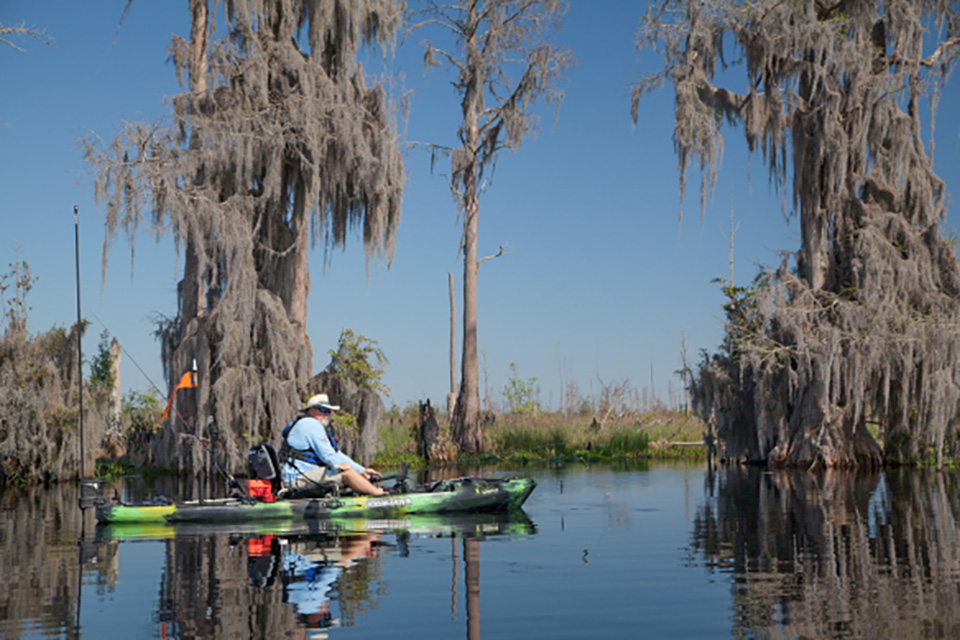
Largemouth bass, crappie, bluegill, shellcrackers, and channel catfish… all species that you can forget about catching on a fishing trip to the “land of the trembling earth,” the Okefenokee Swamp. The mystical black water of the swamp harbors excellent gamefish populations, but they are of the chain pickerel, bowfin, flier, warmouth, and bullhead catfish variety. All very sporting in their own right, these acid-loving species are often snubbed, except by south Georgia swampers.
There are two main entrances to the approximately 700-square-mile Okefenokee Swamp, the Suwannee Canal Recreation Area off Ga. Hwy 121 near Folkston and the Stephen C. Foster State Park near Fargo. Each has a boat ramp and boat rentals. Both entrances have impressive visitor centers and both offer boat tours of the swamp for a fee. Cabins and camping are available at the state park and may be booked through the Georgia State Parks central-reservations number, (800) 864-7275.
Since I moved to Waycross 12 years ago, I have fallen in love with the swamp. A trip into the swamp is intriguing because you never know what you will encounter. This is a great trip for kids and adults alike, as you will likely see alligators, a plethora of birds and other animals, and quite likely catch at least several dozen fish of varying species.
My favorite targets in the swamp are fliers. These black-backed, emerald-green-sided panfish are a handful when caught on a bream-buster pole. With black spots on their sides, they look like a crappie, but they have a small mouth like a bluegill. In March, you will catch mostly five- to eight-inch fish, but you will occasionally catch a nine- or 10-inch fish that will weigh in at 3/4-lb. or more. As a Georgia DNR fisheries biologist, I certified the world record flier back in 1996. That 1-lb., 4-oz. whopper was caught from a pond near Valdosta. On any given trip to the swamp, fish that size are doubtful, but quite a few fish approaching a pound have been caught during the last year.
My favorite presentation for flier is pitching a yellow sally. Flier will readily scarf up this little yellow fly either fished weightless or with a super-small split shot and suspended under a small float. To get rigged up, take a very light-tipped bream buster (Little Jewels are a great choice) and string it the length of the pole with 8-lb. test Sufix Invisiline Flourocarbon. The super-clear characteristics of fluorocarbon are not as much of an advantage in the dark water as the increased abrasion resistance you get from this type of line. When banging it around lily pad stems and vegetation all day, you will notice fluorocarbon line will hold up much better than monofilament. Next, you can either tie on a small snap (small Fas-Snap brand snaps work great) or directly tie the sally to the line. If the fish will not take it near the surface, you can fish the rig deeper by squeezing a No. 10 Bass Pro Shops clam-shot a couple inches above the sally and suspending it under a small float. If you live more than an hour from the swamp, you probably will not be able to find yellow sallies at your local tackle shop. The only place I have ever seen sallies sold is in tackle shops in Waycross, Folkston, Fargo, and Homerville (all towns surrounding the swamp). If you are so inclined, you can purchase fully-rigged and ready-to-fish poles at the Okefenokee Adventures store located at the Folkston entrance to the swamp.
A little, white “maggot” addition to the back of the sally sweetens the pot and usually improves your catch. I am not referring to a fly larva, but a small piece of white plastic worm. One plastic worm will make a year-long supply of the little trailers. Cut off a very small, square piece of the white worm and impale it on the sally hook.
To effectively fish the lure, flip the sally among lily-pad clumps and other vegetation. Let the lure sink until it is just out of sight, and twitch it again. You are trying to imitate the subtle movement of aquatic insects, so do not overdo the action. The bite usually entails the lure simply disappearing. Leave your bass hookset at home, and simply flick your wrist to set the hook. After a few small fish fly over your head on the hookset, you will get the hang of it. Do not be surprised to hook a pickerel or bowfin, as they will also munch a sally dabbled in front of them.
Pickerel are the top predators (except alligators!) in the system. While you will sporadically catch one while pitching a yellow sally, they are more effectively targeted with inline spinners. These lures are effective both trolled and cast for chain pickerel and its smaller cousin, the redfin pickerel.
Ronny Lynn, a life-long resident of Waycross, has chased pickerel, or jackfish as they are locally called, for decades.
“When I was a kid, my daddy taught me how to catch jackfish by trolling King Jack Spinners,” Ronny said.
His favorite silver-bladed spinner with yellow, white, and red feathers encircling the treble hook is still available at tackle shops around the swamp. The lure will catch both pickerel and bowfin, depending upon how fast you troll it.
“To determine the right trolling speed for jackfish, troll the bait fast and then speed up a little bit. You can’t troll it too fast for a jackfish, but you’ll only catch mudfish if you slow down,” he shared.
In recent years, Ronny has moved away from trolling and now prefers casting inline spinners to pickerel in the lakes scattered throughout the swamp. Pickerel love to nestle up to a shallow grass or lily-pad clump. An inline spinner retrieved quickly past the thick vegetation will frequently draw a strike.
“The last few years, it seems the white spinners have been the best,” he noted.
Warmouth are sometimes caught with lures, but live crayfish are deadly on the panfish. In the spring, locals use crawfish rakes in the flooded roadside ditches to collect a few dozen before each trip. Warmouth cannot resist a three-inch or smaller crayfish impaled on a No. 2 aberdeen hook and dabbled in an old cypress stump. Bream-buster poles are the standard, but you can also use spincast or spinning gear to pitch the crayfish to likely spots.Stephen Foster State Park is the best access for warmouth, as there are many cypress stumps scattered around the banks of nearby Billy’s Lake.
Bullhead catfish are the scavengers of the swamp. Their populations have boomed during the last couple of wet years. Kevin Hart, a lifelong resident of Fargo, is well known for catching these bottom-dwellers, and his catch has highlighted many a Fargo fish fry. We had to cancel a recent trip due to flooded conditions, but Kevin said the swamp should be back down to fishable conditions by early March, as long as we do not get additional significant rains. He shared with me his approach to filling a stringer with tasty bullheads.
“I catch most of my catfish from cypress stumps and logjams in the swamp,” he said. “The more limbs and tangles, the better.”
If the cover is near the channel or in deeper water, it has potential. He approaches spots from the upstream side and anchors just upstream from the cover. Even though there is only a light current in the swamp, there is enough to sweep your bait down among the tangles and keep the line tight.
“You can just count on getting hung up, but those ‘hangy’ places are the best. Make sure to bring plenty of sinkers and hooks,” he said.
He uses a Carolina rig consisting of a No. 4 or No. 2 blue aberdeen hook tied about six inches below a swivel and as small of an egg sinker as will hold bottom. Usually a 1/8-oz. weight will hold, but it sometimes takes more. He recommends using 10- or 12-lb. test main line and a couple pounds lighter test leader so that you can break off just the hook if you hang. He saves a lot of hooks by using aberdeen models because the light wire usually bends before breaking off.
Kevin prefers shrimp for bait. He usually buys several pounds of fresh, medium or large food-shrimp and freezes them in 1-lb. packages, so he always has bait ready to go. Before baiting up, he peels the shrimp and cuts each one into about four or five pieces.
“This year the catfish action has been so good I often can’t fish more than one pole,” Kevin affirmed. “I’ve also caught more mudfish this year than in a long time.”
Bowfin, also known as mudfish, are a nemesis for bass-tournament anglers, but they are sporting quarry if you are not in competition. Like them or not, you will usually catch some no matter which species you fish for in the swamp. If you want to target bowfin, cast a 1/16-oz. white/red dot Beetlespin when the water is warm and a four-inch plastic worm when it is cold. I occasionally target bowfin. When I do, my favorite presentation is a Texas-rigged Bass Assassin four-inch worm in red/pearl belly or black/chartreuse tail. A 1/8-oz. worm weight is usually enough to keep the lure on the bottom as you slowly crawl it back to you. Lily pads are the best cover to try for bowfin.
Water levels in the swamp can affect fishing success. Immediately after a significant rain, if the water level rises several inches to a foot, the fish typically spread out into the newly flooded flats. Under these conditions, the fishing is typically poor, but after a week of stability, the fishing will usually improve. If you want to check water levels before a trip, you can call the Stephen C. Foster State Park office at (912) 637-5274.
As part of the U. S. Fish and Wildlife Service National Wildlife Refuge System, the Okefenokee Refuge has some special regulations. The entrance fee requirement may be met in several ways. The $5 per car weekly entrance fee can be paid at either the state park or refuge entrances. Alternately, a Federal Duck Stamp, Refuge Annual Pass, or other Federal Recreation Passport suffices for the daily entrance fee. A Georgia fishing license is required to fish in the Okefenokee, and statewide size and creel limits apply. Do not hitch up your 22-foot Nitro bass boat with a 225 hp Optimax and drag it to the swamp, as there is a 10 hp maximum on outboard motors. The perfect swamp rig is a lightweight jonboat with a 9.9 horsepower outboard and a trolling motor. If you do not have the necessary rig, you can rent one (minus the trolling motor) from either the Folkston or Fargo entrances.
Additional regulations apply, so I suggest that before venturing into the swamp, you call the refuge office (912) 496-7836 or visit their website at http://okefenokee.fws.gov.
If you can put aside visions of catching trophy bass, you will thoroughly enjoy a fishing trip to one of our Georgia treasures. Customize your tackle based upon these recommendations, and your arms will likely be sore when you leave the land of the trembling earth.

